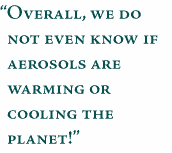|
Atmospheric Aerosols: Fossil Fuel and Biomass Burning
There is yet another impact of biomass burning on the energy budget of
the planet—such burning produces tiny smoke particles called
"aerosols."
These aerosols can be either cooling or warming depending on how much
solar radiation they absorb versus how much of it they scatter back to
space. Close to the burning area, smoke clouds can look almost black,
indicating strong absorption, while further downwind they may look white,
indicating weaker or no absorption. Fossil fuel burning in automobiles,
factories, and power plants also add aerosols to the atmosphere while
polluting clouds (Figure 4). These aerosols are thought to absorb less
solar radiation than those produced by biomass burning, but the exact
amount of absorption from each type of aerosol is not yet known. Overall,
we do not even know if aerosols are warming or cooling the planet! This
depends critically on how much aerosol is present, how absorptive the
aerosol is, how large the aerosol particles are, and how high the aerosol
is in the atmosphere. For example, the aerosols emitted by the Mt.
Pinatubo eruption in 1991 were very small particles that absorbed very
little sunlight and primarily reflected it. As predicted, the aerosols
from Mt. Pinatubo acted to cool the planet for a couple of years before
settling out of the atmosphere. Man-made aerosols tend to be processed
out of the atmosphere by clouds within a few weeks.

Figure 4: Clouds polluted by aerosols from factories have more numerous and smaller drops, causing the cloud to become brighter and reflect more
of the Sun's radiative energy.
As the number of aerosols increases, the water in the cloud gets spread
over many more particles, each of which is correspondingly smaller.
Smaller particles fall more slowly in the atmosphere, and decrease the
amount of rainfall. In this way, changing aerosols in the atmosphere can
change the frequency of cloud occurrence, cloud thickness, and rainfall
amounts. Even the tiny aerosols (typically less than 50 millionths of an
inch or 1 micron across) can affect the clouds, which in turn can change
the radiation balance of the planet. Thus, aerosols can have both a
direct effect on the energy balance, as well as an indirect effect
(through clouds). It is thought that the indirect effect of aerosols can
be even larger than their direct effect, but at present it is not known
whether such an effect is a net cooling or warming of the planet.
back: Surface Absorption and Reflection
next: From Measurements to Climate Models
|
|

- Why isn't Earth as hot as an oven?
- Introduction
- Clouds: A hot topic or are we made in the shade?
- Surface Absorption and Reflection
- Atmospheric Aerosols: Fossil Fuels and Biomass Burning
- From Measurements to Climate Models
- Related Data Sets:
- Surface Temperature
- Outgoing Longwave Radiation
|


